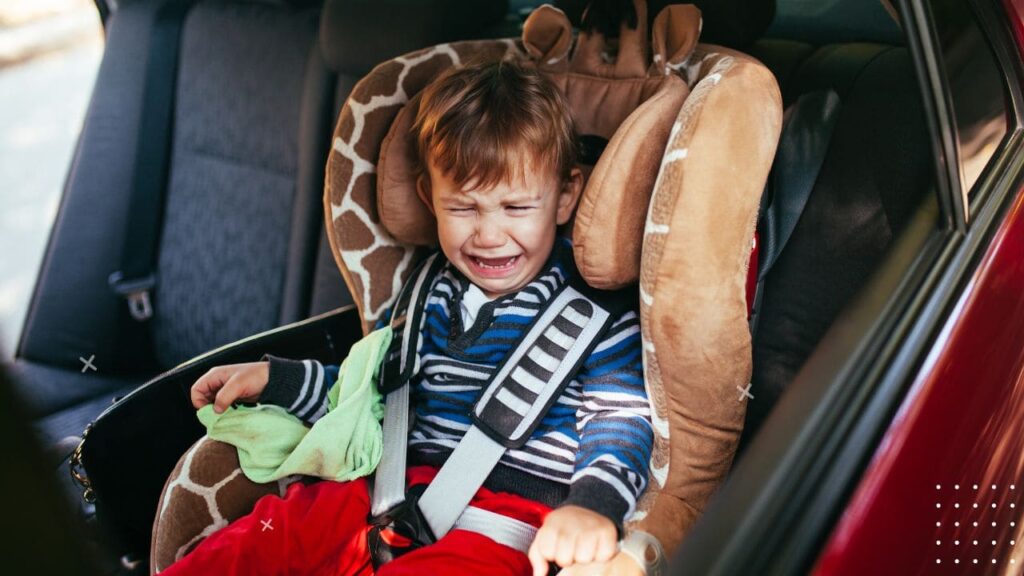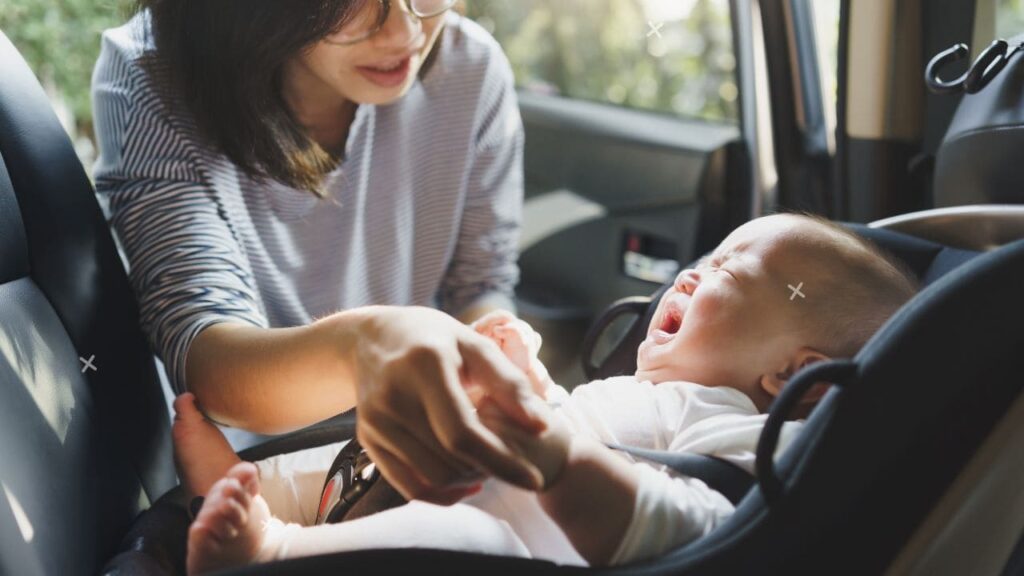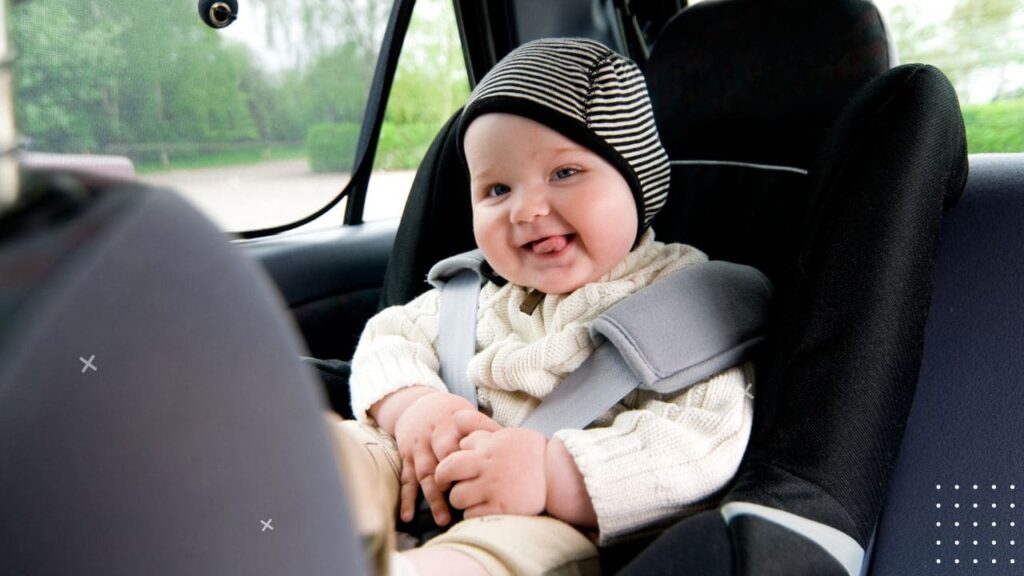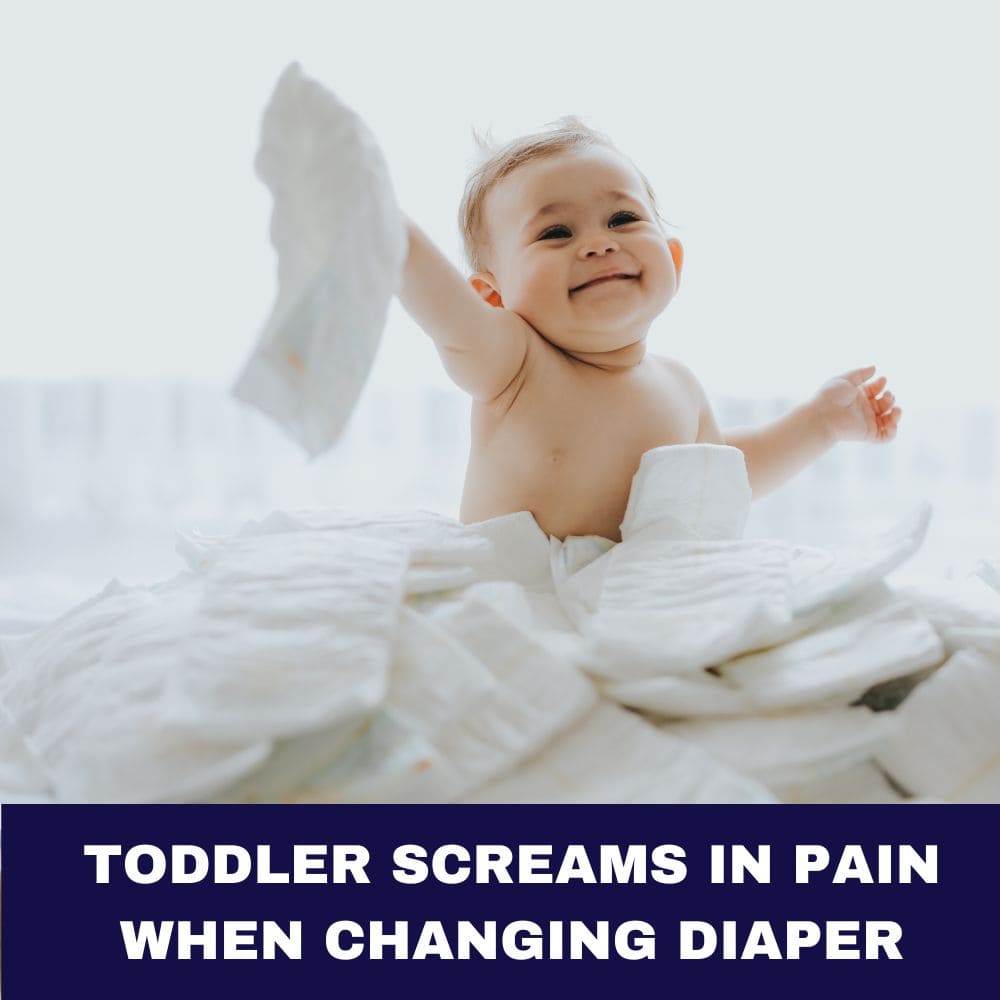As a parent, few things are more stressful than when your baby starts wailing at the top of their lungs in the backseat. You’re just trying to get from point A to point B, but their intense baby crying in car seat threatens to derail the whole trip. Believe me, I’ve been there! When my daughter was born, car rides often felt like I gripped the steering wheel white-knuckled while she screamed despite my best efforts to soothe her distressed cries in the car seat.
After many frustrating trials and errors, I eventually discovered strategies that dramatically reduced the baby crying in car seat episodes and made our drives much more bearable. I want to share what I learned so you can also troubleshoot this common parenting challenge. While some fussiness is inevitable, you can try several effective tips to minimize unhappy tears and make traveling less stressful for everyone.

Why Does My Baby Cry in the Car Seat?
Before diving into the solutions, it helps to first understand the possible reasons behind the crying. This way you can pinpoint the triggers specific to your little one. Common culprits include:
- Discomfort – An ill-fitted harness, improper recline angle, scratchy fabrics or other issues with the car seat itself may irritate your baby and spur crying.
- Hunger – Trip timing that overlaps with your baby’s feeding schedule could spark fussy behavior signaling their need to eat.
- Boredom – Infants easily get bored when inactive, yet strapped into a car seat unable to freely move around and explore. Crying may simply express their desire for stimulation.
- Overstimulation – On the flip side, the constant motion of the moving vehicle can overstimulate some babies and translate to upset tears.
- Acid reflux – The inclined position may also aggravate babies with reflux, causing discomfort and spurring their cries.
- Dislike of confinement – Your baby could just hate feeling restricted in a car seat, wanting freedom of movement.
- Feeling isolated – Similarly, without you close, they may feel abandoned and alone, triggering sad tears.
Okay, so now that we better understand the why behind the waterworks, let’s get into tactics you can implement to transform those car rides!
Car Seat Basics: Tackling Discomfort
Physical irritation is one of the most common yet overlooked reasons for crying. Take steps to maximize your baby’s comfort in their car seat. This includes:
- Check harness tightness – Too loose and your baby won’t be safely secured. But overtightened straps dig into their soft skin and restrict movement. Re-read the car seat manual and ensure a snug but not suffocating fit.
- Consider switching car seats – If you’ve double checked the installation and your baby still cries, the model itself could be the culprit. Try a different style or brand better suited to their size and shape.
- Ensure proper head, body and temperature support – Use inserts, rolled towels/blankets or adjustments to provide cushioning, limit slouching over, and protect sensitive spots.
Getting the basics like your baby’s seating position, fabrics and temperatures right goes a long way toward happier travels. Don’t hesitate to experiment with small tweaks that improve their comfort. You’ll quickly learn what works for your child.
| Age | Weight Range | Type of Seat |
|---|---|---|
| Newborn to 12 months | Up to 22 lbs | Rear-facing only infant seat |
| 1-3 years old | 20-40 lbs | Convertible or combination seat (rear-facing) |
| 4-7 years old | 40-60 lbs | Combination seat (front-facing) or high back booster |
| 8+ years old | 60+ lbs | Backless booster seat |

Next Steps for Comfort
After checking car seat harness tightness, head support and other components, try a short 10-15 minute test drive around your neighborhood to experiment with additional padding or inserts. Gauge if your baby still cries or if the adjustments help. Don’t forget to also pack an extra blanket or light jacket to quickly adapt to temperature changes over longer drives. Remaining observant and responsive to discomfort helps minimize frustrating crying episodes.
Strategize Trip Timing Around Naps and Feedings
Any experienced parent knows a well-fed, well-rested baby equates to a happy baby. So the easiest route to tear-free car rides is strategically planning them around your infant’s basic needs.
If possible, try to schedule longer treks to begin right after they wake up from a nourishing nap and/or finish a filling feeding. This helps ensure they start the trip feeling fresh, comfortable and content.
Their sense of distress escalates rapidly when exhaustion or hunger pangs kick in. So checking diapers, allowing them ample eating opportunities, and timing naps prevent most mid-route meltdowns. As an added tip, you can also try nursing or bottle feeding your baby as you start driving to help lull them to sleep for part of the ride.
Next Steps for Trip Timing
When planning longer distance travels, map out some pitstops in advance where you can briefly pull over if needed to feed, change or soothe your baby. Pack food, diapering essentials and other must-have items within easy reach. Then schedule the drive’s start time to leverage your child’s natural sleep-wake cycles and meal times. These small actions take some coordination but make all the difference.
Keep Your Baby Engaged with Toys and Activities
Alright, your baby’s basic needs are met but the crying continues. This likely signals boredom from confinement in their seat with minimal stimulation. Luckily, providing distraction with interactive toys or activities gives their brains something constructive to focus on.
Great options include:
- Car seat toys like soft plush figures within grasping reach or plastic rings on ribbons hanging from the handle.
- Clip-on toys affixed to the seat itself featuring different textures, lights or sounds to capture interest.
- Singing songs like “Wheels on the Bus” or “The Itsy Bitsy Spider” with engaging hand motions.
- Playing kid-friendly music or nursery rhymes provides auditory distraction.
- Attaching a small mirror to let them peek at your reflection and maintain connection.
Don’t go overboard with too much visual or auditory input though, as overstimulation could backfire and cause tears. Find a balance through trial and error.
Next Steps for Engagement
Pack a “car bag” with a rotating mix of exciting new toys and books to battle boredom. Rotate these items out weekly to inject novelty. Pro tip: Save a favorite comfort item or stuffie exclusively for the car seat to get your child eager about riding. Establish this positive association early on for cooperative travels later!

Be Prepared to Pull Over When Necessary
Sometimes no matter how strategic your timing or engaging the distractions, babies reach a point on longer car rides when it becomes too much. They meltdown in tears and cannot be consoled without taking a breather from the seat. In these scenarios, your safest bet is pulling over to address the issue.
Scout out rests stops, gas stations, grocery store parking lots or other safe pullover areas along your route. Do not attempt extensive soothing like nursing or diaper changes while actively driving. And absolutely never remove or improperly secure your baby from the car seat while the vehicle is motion.
By temporarily parking and tending to your baby, their upset diminishes. You avoid hazardous multitasking behind the wheel. And everyone exits calmer and more centered to complete the final leg of your trip. Those few additional minutes stopping makes all the difference compared to a spiral into panicked tears (both theirs and yours!).
Next Steps for Pit Stops
Pack an organized diaper bag so you can swiftly address needs like feeding, changing or general comforting during quick break stops. Help returning your upset baby to a tranquil state first before buckling them back into the car seat again. Also, build in extra buffers into travel time estimates knowing occasional unexpected crying fits or pullovers add delays. Just breathe and take such pit stops in stride. Soon your child will outgrow such disruptions.
Consider White Noise or Soothing Music
I discovered firsthand how a screaming infant instantly settles to sleeping angel with just a simple soundtrack shift. While driving over mountain passes, the loud hum of the car engine and tires on the highway lulled my daughter into sudden silence. Yet when we slowed through a traffic jam or quiet rural stretch, her contentment shattered.
Through this pattern, I deduced the rhythmic noises reminded her of the white noise from inside my noisy womb! I recreated this audio cocoon feel using a downloaded white noise app on my phone paired with mini clip-on speakers secured near her car seat headrest. Viola – no more crying fits amid quieter drives!
If white noise proves too artificial, try streaming a soft lullaby playlist instead. Though take care not to select overstimulating nursery rhyme tunes. Stick to gently paced instrumentals to relax not rile your little traveler up.
Next Steps for Audio Input
Experiment alternating between white noise tracks or muted calming instrumentals during car rides to prevent crying fits. Discover which audio backdrop best promotes your child’s cooperation over longer distances. Continue playing this sounds once home during naps or bedtime to solidify positive associations, potentially even phasing out the crutch eventually as your baby learns to self-soothe without it.

Try Introducing a Pacifier
Some babies naturally suck on fists or fingers to self-soothe. Pacifiers simply substitute a sterile rubber alternative while satisfying their instinctive sucking reflex. The rhythmic motion combined with feeling content after feeding often lulls cranky babies fast asleep.
If you breastfeed, wait until initial nursing is well established, usually around 3-4 weeks old, before introducing a pacifier. This ensures you don’t inadvertently interfere with supply regulating.
Tip the pacifier’s nipple until the side touches baby’s lips allowing them to latch on using their tongue. Never forcefully push it into their mouth. And provide only for soothing not prolonging between feeds.
Over time, your baby may even learn to replace tears with happily sucking their “plug” when upset in the car seat! As a backup soothing measure, pacifiers certainly deserve consideration.
Next Steps for Pacifiers
Try introducing your breastfed baby to pacifiers for the first time when a longer car ride conveniently coincides with their next feeding window. Offer your breast first. Then when displaying early hunger cues on the road shortly after, break out the pacifier to see if it satisfies cries. Rinse with sterilized water between trips preventing germ transfer.
Invest in a Quality Car Seat
When sourcing your baby’s first car seat, you’ll quickly discover a dizzying array of options from budget to luxury. But here’s the inside tip – don’t just default to the cheapest model. Investing in an exceptional seat engineered specifically to minimize discomfort and maximize security for delicate babies can transform those nightmarish car rides.
Prioritize these features when selecting a seat:
- Ergonomic design – Contoured shells with padded inserts, breathable fabric etc. prevent pinching and rubbing.
- Side impact protection – Extra barrier padding and structural reinforcements prevent injury in collisions.
- Adjustable harness heights – Accommodate your rapidly growing baby longer before needing to “size up”.
- User-friendly installation – Complicated setups lead to improper and therefore unsafe use.
While pricier initially, the cost per use makes a premium car seat worthwhile for confident travelers. Do your research and select the one catering best to your baby’s unique needs.
Next Steps for Car Seats
Before baby’s arrival, study car seat reviews and create a shortlist of top-rated options for your car model. Weigh the merits of each based on safety testing results and specialized features benefiting infants. Then inspect, test install and harness in the options first-hand in store buying the absolute best match for your child rather than settling. Properly used, it protects your precious cargo for years to come.

Practice Short Local Trips as “Test Runs”
If your baby reliably cries when strapped into their seat, they likely associate riding with past unpleasant experiences. Break this cycle by taking short local trips around the neighborhood for “practice runs”. Choose a consistent route your baby soon becomes familiar with.
At first, keep these test drives very brief – even just 5-10 minutes circling the block. Helping your child overcome their habituated response and realize outings don’t have to involve distress. Over subsequent trips, gradually increase duration once previous durations pose no problems.
Eventually these successful exposures rewire baby’s mindset toward cooperation not crying when it’s time to hit the road. Just remember patience and keeping trips positive until they generalize this new perspective.
Next Steps for Test Runs
Plan a few short test drive practice runs three days in a row at a consistent timed interval when your baby is typically happy, such as right after nursing. Briefly praise and offer a toy upon completing each tear-free trip before slowly extending the drive’s length. Consistency coupled with your reassuring presence builds baby’s confidence until longer rides become no big deal!
| Trip Number | Duration | Route |
|---|---|---|
| 1 | 5 minutes | Left from driveway, circle block, return home |
| 2 | 5 minutes | Same route as trip 1 |
| 3 | 10 minutes | Add one extra side street to route |
| 4 | 10 minutes | Same extended route as trip 3 |
| 5 | 15 minutes | Drive to second neighborhood over and back |
Crying Doesn’t Mean You’re “Failing”
As tough as it sounds, accept that babies cry…it’s simply what they do! Their language skills aren’t yet proficient enough to neatly communicate their array of needs and feelings beyond crying. So some fussing inevitably accompanies the inability to rationalize sensations like hunger, boredom or overstimulation.
Rather than feeling like a “bad parent” when your best efforts fail to console their tears, stay patient while continuing to trial and error what helps. Whether simply wanting connection, release of tension or communicating an unmet need, try meeting your baby where they’re at.
Over long travels, plan occasional stops to replenish your own sanity too! This challenging period certainly doesn’t last forever. One day you’ll actually miss their little baby sounds.
Safety First!
Through all of this, your top priority remains properly securing your baby in their car seat every trip without exception. An excellent seat means nothing if improperly fastened or adjusted. And never succumb to the temptation of emergency roadside stops for care while still in motion.
I cannot stress enough – no matter how deafening the cries, keep driving until safely pulled off road and in park before interacting. It’s also unsafe to drive constantly turned around to soothe them. Secure their seat out of your eyeline so you focus ahead and get where you’re going alert, avoiding potential hazards.
Your baby’s precious cargo. Transport them as such, remaining vigilant that their restraints stay tightly fastened and the seat angle reclined appropriately. Regularly double check the installation hasn’t loosened or shifted. Never risk their safety or yours by cutting corners. Stay the course and remain committed to smart practices.
This too shall pass! Before you know it, the car evolves into a space of playful tunes and two-way conversation. In the meantime, stay consistent applying these tips to dramatically minimize the crying and keep your travels together on track.
You’ve got this! Now buckle that baby in and venture on to your next family adventure with confidence.
FAQ – Baby Crying in Car Seat
Why does my baby cry every time I put them in the car seat?
There are a few common reasons this happens – discomfort from improper fit, boredom being restricted, overstimulation from the car motion, hunger before a feeding, or just disliking the confinement. Check for any pain points with straps or positioning. Time trips just after naps/feeds. Provide toys for engagement. Limit environmental stimuli. Consider trying a pacifier too for self-soothing.
How can I tell if my baby’s car seat harness is too tight or too loose?
A snug, properly tightened car seat harness limits movement without squeezing the baby. You should only be able to pinch about an inch where the straps cross the collarbone. Too loose and the baby can easily wiggle/slump down, risking ejection. Too tight can dig painfully into skin or restrict breathing. Adjust in small increments for the right close fit.
What kind of car seat toys should I use to keep my baby entertained?
When strapped in, babies need visual, audio, and physical stimulation. Soft plush dangling toys, plastic links & rings, clip-on light-up/musical toys, handheld rattles, books with touch elements, and mirrors are all great boredom-busters. Rotate new toys weekly for ongoing novelty too.
My baby seems uncomfortable sitting reclined in her car seat – help!
Some babies have excessive reflux and dislike the inclined car seat angle. First try rolling a blanket under the base to slightly recline the seat further. You can also buy accessory “infant positioners” to help keep your baby cozy. If it persists, talk to your pediatrician in case medication is needed to ease any ongoing pain/discomfort while riding reclined.
What things should I have on hand in the car to quickly soothe baby crying fits?
- Be prepared for spontaneous meltdowns! Have essentials like water, pacifiers, gas drops, a favorite toy or blanket, diaper change pad, non-messy snacks/milk and pullover options like your trusted nursing cover. Pulling over temporarily when possible also gives both you and baby a needed breather. If crying persists, call your pediatrician to rule out any underlying issues.











